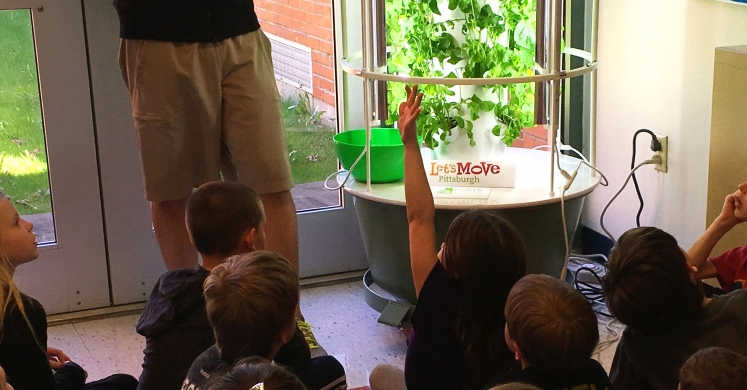Blog

Health in Motion: Curtisville Primary Educational Garden
Brought you by Let’s Move Pittsburgh, the Health in Motion blog series is intended to showcase the efforts of schools and community organizations in the Pittsburgh region who are leading children to a healthier future. A new project with a guest author or interviewee will be featured each month. Let’s Move Pittsburgh hopes that Health in Motion will encourage leaders to adopt healthy programs in their communities and inspire readers to make healthy changes in their own lives.
Ron Nichols is the Health and Physical Education Teacher at Curtisville Primary Center in the Deer Lakes School District.
I truly believe it is important for students to understand why they are learning a particular concept. For the past few years, I've spent time investigating ways to implement a garden into our nutrition education to help teach my students why it is important to eat a balanced diet. Due to the growing season in our area, I found it difficult to find something we could grow during the school months that was also low maintenance enough not to interfere with other areas of learning.
A parent in our school mentioned hydroponic gardening. When I heard that, I remembered seeing that type of thing at Epcot and I thought there was no way we could do that here at school! After some investigation, I found the Tower Garden to be a great option for our setting. Although there are other options for hydroponic gardening, the Tower Garden was a simple and easy way to implement our objective of allowing students to experience growing and tasting their own food.
The first crop we chose to grow was arugula. This choice allowed students to grow and eat a food many of them have never heard about or tasted. To start our nutrition unit, each class planted an arugula plant in our Tower Garden. Each week, we would check on our plants and learn new nutritional information about arugula. We had first grade students learning that arugula has phytonutrients! It was amazing! When the plants matured, we harvested them. Personally, it was a really fulfilling day when every child in our school got to try a salad with their very own arugula in it. The students had the ability to identify what part of their salad was arugula and know much of the nutritional information about it. Some students just ate the salad normally. Others pulled the arugula out and ate it first. One boy even pulled it out and put it on his pizza! Even the children who were not buying a school lunch that day were given a salad to try. Thanks to the Let's Move Pittsburgh Champion Schools Grant, our students were given the ability to learn how to grow their own food and then taste it as well! During the process, I took the time to jot down some interesting quotes that I heard from children either during class or while they were walking by the Tower Garden in the hallway. Included below are just a few of the more interesting ones:
- “I'm going to buy a salad when it's ready.”
- “Is that going to turn into food?”
- “That looks delicious! I can't wait to eat it.”
- When reviewing about phytochemicals, I mentioned that it helps fight off cancer. A first grader raised his hand and told me "everyone knows that."
- “What happened to the arugula? They trimmed it! I can't wait to eat it! I love arugula!”
- “It's a little spicy, but I like it.”
- “I don't like it by itself.”
- “It's the best part of the salad.”
- “I'm going to ask my grandma and papa for some to plant in our garden. This is good! I already ate the whole thing! It is yummy!”
I polled the students in class over the next couple of days to see what their true opinion of arugula was. Here are the results:
- “Yes, I liked it and want to eat again.” (102 students)
- “It was okay. I would try it again.” (85 students)
- “Nope. I do not prefer it.” (87 students)
All in all, the ease of growing this type of garden in a school and the educational value to the students far surpasses the cost, time and effort needed. I recommend this endeavor to anyone interested in introducing a school garden into your wellness plan.
